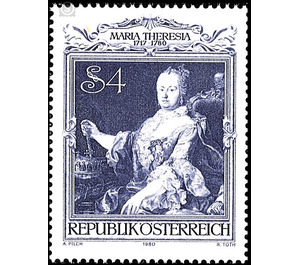200th anniversary of death - Austria / II. Republic of Austria 1980 - 4 Shilling
Theme: Art & Culture
| Country | Austria / II. Republic of Austria |
| Issue Date | 1980 |
| Face Value | 4.00 |
| Color | blue |
| Printing Type | Typography |
| Stamp Type | Commemorative |
| Item Type | Stamp |
| Chronological Issue Number | 982 |
| Chronological Chapter | OOS-OE2 |
| SID | 228795 |
| In 82 Wishlists | |
After the death of Emperor Karl VI. On October 20, 1740, Maria Theresia succeeded him as ruler in the Austrian ancestral lands. But the line of those who wanted to dispute the throne of the young princess was great. As a result, began by the claims of various European countries of the "Austrian Succession War", which lasted from 1740 to 1748. Despite all inexperience, the young Empress accepted this challenge. Her most important advisor at this time was Johann Christoph Freiherr von Bartenstein (1689-1767). In her distress she found help especially in Hungary. Only the Peace of Aachen of 1748 ended the state of war with the neighboring states of Austria. The essential foundations of the "Pragmatic Sanction" were successfully defended by Maria Theresia. Only the largest part of Silesia was lost to Prussia and the small northern Italian duchies of Parma, Piacenza and Guastalla. Silesia was to become another serious trial for the Empress only a few years later. For to protect Silesia, Frederick II invaded Prussia in 1756 in Saxony, thus triggering the Seven Years' War. It ended only 1763 by the Hubertusburger peace of the Silesia at Prussia left. The brand motif shows Maria Theresa with St. Stephen's crown after a work by Martin van Meytens (1695-1770).


